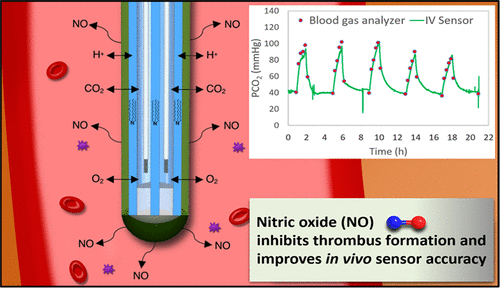当前位置:
X-MOL 学术
›
Anal. Chem.
›
论文详情
Our official English website, www.x-mol.net, welcomes your
feedback! (Note: you will need to create a separate account there.)
Enhanced Hemocompatibility and In Vivo Analytical Accuracy of Intravascular Potentiometric Carbon Dioxide Sensors via Nitric Oxide (NO) Release.
Analytical Chemistry ( IF 6.7 ) Pub Date : 2020-09-21 , DOI: 10.1021/acs.analchem.0c02979 Qi Zhang 1 , Griffin P Murray 1 , Joseph E Hill 2 , Stephen L Harvey 2 , Alvaro Rojas-Pena 2, 3 , Jonathan Choi 1 , Yang Zhou 4 , Robert H Bartlett 2 , Mark E Meyerhoff 1
Analytical Chemistry ( IF 6.7 ) Pub Date : 2020-09-21 , DOI: 10.1021/acs.analchem.0c02979 Qi Zhang 1 , Griffin P Murray 1 , Joseph E Hill 2 , Stephen L Harvey 2 , Alvaro Rojas-Pena 2, 3 , Jonathan Choi 1 , Yang Zhou 4 , Robert H Bartlett 2 , Mark E Meyerhoff 1
Affiliation

|
In this letter, the innate ability of nitric oxide (NO) to inhibit platelet activation/adhesion/thrombus formation is employed to improve the hemocompatibility and in vivo accuracy of an intravascular (IV) potentiometric PCO2 (partial pressure of carbon dioxide) sensor. The catheter-type sensor is fabricated by impregnating a segment of dual lumen silicone tubing with a proton ionophore, plasticizer, and lipophilic cation-exchanger. Subsequent filling of bicarbonate and strong buffer solutions and placement of Ag/AgCl reference electrode wires within each lumen, respectively, enables measurement of the membrane potential difference across the inner wall of the tube, with this potential changing as a function of the logarithm of sample PCO2. The dual lumen device is further encapsulated within a S-nitroso-N-acetyl-DL-penicillamine (SNAP)-doped silicone tube that releases physiological levels of NO. The NO releasing sensor exhibits near-Nernstian sensitivity toward PCO2 (slope = 59.31 ± 0.78 mV/decade) and low drift rates (<2 mV/24 h after initial equilibration). In vivo evaluation of the NO releasing sensors, performed in the arteries and veins of anesthetized pigs for 20 h, shows enhanced accuracy (vs non-NO releasing sensors) when benchmarked to measurements of discrete blood samples made with a commercial blood gas analyzer. The accurate, continuous monitoring of blood PCO2 levels achieved with this new IV NO releasing PCO2 sensor configuration could help better manage hospitalized patients in critical care units.
中文翻译:

通过一氧化氮 (NO) 释放提高血管内电位二氧化碳传感器的血液相容性和体内分析准确性。
在这封信中,一氧化氮 (NO) 抑制血小板活化/粘附/血栓形成的先天能力被用来提高血管内 (IV) 电位P CO 2(二氧化碳分压)传感器的血液相容性和体内准确性. 导管式传感器是通过用质子离子载体、增塑剂和亲脂性阳离子交换剂浸渍一段双腔硅胶管制成的。随后填充碳酸氢盐和强缓冲溶液并分别在每个管腔内放置 Ag/AgCl 参考电极线,从而能够测量管内壁的膜电位差,该电位随样品对数变化磷一氧化碳2。双腔装置进一步封装在S-亚硝基-N-乙酰基-DL-青霉胺 (SNAP) 掺杂的硅胶管中,可释放生理水平的 NO。NO 释放传感器对P CO 2(斜率 = 59.31 ± 0.78 mV/decade)和低漂移率(初始平衡后 <2 mV/24 h)表现出接近 Nernstian 的敏感性。在麻醉猪的动脉和静脉中进行 20 小时的 NO 释放传感器的体内评估显示出更高的准确性(与非 NO 释放传感器相比),当以商业血气分析仪对离散血液样本的测量为基准时。准确、连续监测血液P CO 2这种新的 IV NO 释放P CO 2传感器配置所达到的水平可以帮助更好地管理重症监护病房的住院患者。
更新日期:2020-10-21
中文翻译:

通过一氧化氮 (NO) 释放提高血管内电位二氧化碳传感器的血液相容性和体内分析准确性。
在这封信中,一氧化氮 (NO) 抑制血小板活化/粘附/血栓形成的先天能力被用来提高血管内 (IV) 电位P CO 2(二氧化碳分压)传感器的血液相容性和体内准确性. 导管式传感器是通过用质子离子载体、增塑剂和亲脂性阳离子交换剂浸渍一段双腔硅胶管制成的。随后填充碳酸氢盐和强缓冲溶液并分别在每个管腔内放置 Ag/AgCl 参考电极线,从而能够测量管内壁的膜电位差,该电位随样品对数变化磷一氧化碳2。双腔装置进一步封装在S-亚硝基-N-乙酰基-DL-青霉胺 (SNAP) 掺杂的硅胶管中,可释放生理水平的 NO。NO 释放传感器对P CO 2(斜率 = 59.31 ± 0.78 mV/decade)和低漂移率(初始平衡后 <2 mV/24 h)表现出接近 Nernstian 的敏感性。在麻醉猪的动脉和静脉中进行 20 小时的 NO 释放传感器的体内评估显示出更高的准确性(与非 NO 释放传感器相比),当以商业血气分析仪对离散血液样本的测量为基准时。准确、连续监测血液P CO 2这种新的 IV NO 释放P CO 2传感器配置所达到的水平可以帮助更好地管理重症监护病房的住院患者。











































 京公网安备 11010802027423号
京公网安备 11010802027423号